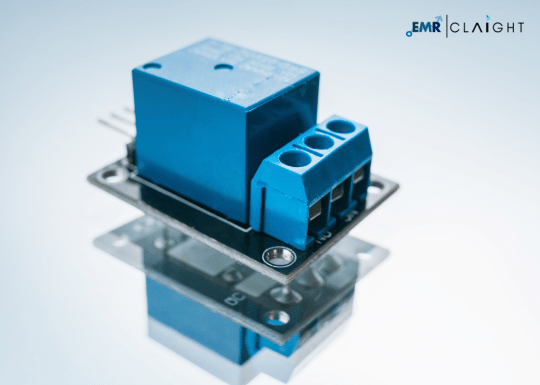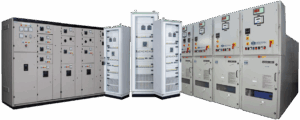The United States relay market is poised for growth, driven by increasing demand for automation, electrification, and safety in industries like automotive, energy, and manufacturing. Technological advancements, such as smart relays and IoT integration, are enhancing the efficiency and reliability of relay systems. Additionally, the expansion of renewable energy sources and electric vehicles is creating new opportunities. The market is also influenced by regulatory standards focused on safety and performance. However, challenges like supply chain disruptions and material costs may impact growth. Overall, the market outlook remains positive with continuous innovation and the adoption of advanced relay technologies.
United States Relay Market Size and Growth
The United States relay market is projected to experience significant growth, with an estimated CAGR of 5.60% from 2025 to 2034. This growth is primarily driven by the increasing demand for electromechanical relays across various industries, including automotive, industrial automation, and telecommunications. The market’s expansion is further fueled by the growing emphasis on energy efficiency and automation technologies.
The power and energy sector’s rapid development, particularly in renewable energy and smart grid technologies, is also a key factor in driving market growth. As the shift towards sustainable energy sources and more complex power distribution systems accelerates, the need for reliable relay systems that ensure safety, efficiency, and fault management becomes critical. The growing adoption of electromechanical relays in these sectors plays a vital role in the overall market expansion, positioning the United States relay market for robust long-term growth.
United States Relay Market Trends
The United States relay market is experiencing several key trends:
Get a Preview with a Free Sample Report
1. Smart and Digital Relays: There is a growing demand for smart and digital relays, which offer enhanced capabilities such as remote monitoring, diagnostics, and IoT integration. These relays enable more efficient and reliable control, especially in industrial automation and power systems.
2. Electromechanical Relay Demand: Despite the rise of digital technologies, electromechanical relays remain in demand due to their simplicity, reliability, and low cost. They are widely used in applications like automotive, industrial control systems, and telecommunications.
3. Renewable Energy Growth: With the expansion of renewable energy sources, such as solar and wind, the relay market is adapting to support the unique requirements of smart grids and renewable energy infrastructure, requiring advanced relay systems for fault detection and power management.
4. Electric Vehicles and Charging Infrastructure: The increasing adoption of electric vehicles (EVs) and the development of EV charging infrastructure are fueling the demand for relays in these applications, particularly for safety and control functions.
5. Focus on Energy Efficiency and Automation: The push toward energy efficiency and automated systems across industries is propelling the need for more advanced relay systems to ensure optimized performance and reduced energy consumption.
Market Opportunities and Challenges
Opportunities
1. Smart Grid and Renewable Energy Integration: The growing shift toward renewable energy and smart grids presents significant opportunities for relay systems, especially for managing power flow, ensuring grid stability, and enhancing fault protection in energy distribution networks.
2. Electric Vehicle (EV) Adoption: As the electric vehicle market grows, there is increased demand for relays in charging stations and EV infrastructure, providing an expanding market for relays tailored for high-voltage applications.
3. Automation and IoT Integration: The increasing trend of industrial automation, driven by IoT and Industry 4.0, offers opportunities for smart relays that provide enhanced control, monitoring, and diagnostics capabilities across various industries, including manufacturing and logistics.
4. Safety Regulations: Heightened focus on industrial and operational safety regulations opens doors for more advanced relay systems to ensure compliance with safety standards in sectors like automotive, industrial, and energy.
Challenges
1. Supply Chain Disruptions: The relay market faces supply chain issues, including shortages of raw materials and components, which can hinder production timelines and increase costs.
2. Cost Sensitivity: While advanced relay technologies are in demand, many industries remain price-sensitive, which can limit the adoption of high-end, feature-rich relays, especially in cost-conscious sectors.
3. Technological Complexity: As relay technologies become more complex with features like IoT integration, the cost and skill required to manufacture and maintain these systems may present barriers for some market players.
4. Competition: The relay market is highly competitive, with numerous domestic and international players vying for market share, making it difficult for new entrants to establish themselves.
United States Relay Market Analysis
The United States relay market is characterized by steady growth driven by advancements in industrial automation, the power and energy sectors, and the increasing demand for reliable control and protection systems. The market is dominated by both electromechanical and solid-state relays, with a rising preference for smart relays that offer enhanced monitoring and diagnostics capabilities. The ongoing shift towards renewable energy sources and smart grid systems is creating a demand for more sophisticated relay technologies to ensure efficient power distribution and fault protection.
In addition, the growing adoption of electric vehicles (EVs) and their associated infrastructure is providing new opportunities for relay manufacturers, particularly in high-voltage control systems. Despite these growth factors, the market faces challenges such as supply chain disruptions, rising material costs, and increasing competition among established players and new entrants. However, the market remains positive, with innovation in relay technology and the continued push for automation and energy efficiency creating long-term growth potential for key industry players.
Competitive Landscape
The key players in the industry includes:
- Robert Bosch GmbH
- TE Connectivity Ltd.
- Denson Corp.
- Eaton Corp. Plc
- Schneider Electric SE
- ABB Ltd.
- Toshiba Corp.
- Panasonic Holdings Corp.
- Sensata Technologies Holding Plc
- Fujitsu Ltd.
- Nidec Corporation
- Others
Read More Trending Report
Media Contact
Company Name: Claight Corporation
Email: [email protected]
Toll Free Number: +1-415-325-5166 | +44-702-402-5790
Address: 30 North Gould Street, Sheridan, WY 82801, USA
Website: www.expertmarketresearch.com






